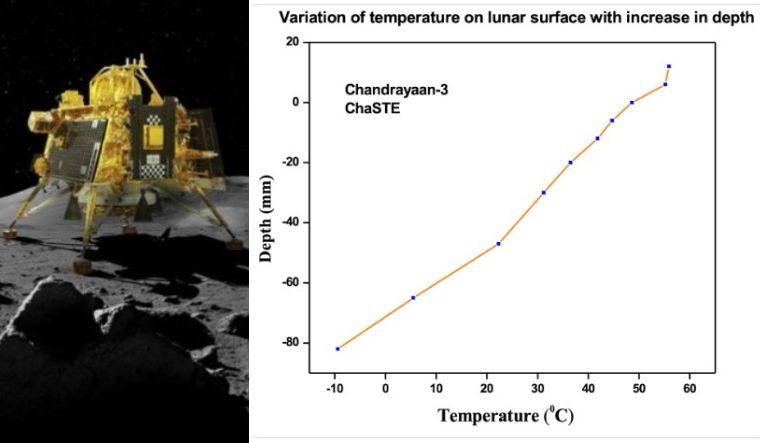With Vikram lander and Pragyan rover beginning to explore the lunar world, all eyes are on new findings in the Chandrayaan-3 mission. In the latest update, ISRO released the first observations from one of the three payloads in the Vikram lander.
The solar-powered Vikram has three payloads. One is the Rambha-LP, which measures the density of near-surface plasma, and monitor its variations in time. Another one is ChaSTE (Chandra's Surface Thermo-physical Experiment), which measures the temperature profile of the lunar topsoil around the pole to understand the thermal behaviour of the moon's surface. The third one is ILSA (Instrument for Lunar Seismic Activity), which serves the purpose of measuring seismicity around the landing site and help delineate the structure of the lunar crust and mantle.
The new observations released by ISRO are from the the ChaSTE payload, which is jointly developed by the Space Physics Laboratory (SPL) in Vikram Sarabhai Space Centre, Thiruvananthapuram, and the Physical Research Laboratory (PRL), Ahemdabad. ChaSTE has a temperature probe equipped with a controlled penetration mechanism capable of reaching a depth of 10 cm beneath the surface.
The temperature probe is fitted with 10 individual thermal sensors. The latest graph released by ISRO illustrates the temperature variations of the lunar surface/near-surface at various depths, as recorded during the probe's penetration. This is the first such profile for the lunar south pole. ISRO said that detailed observations are underway.
The six-wheeled Pragyan rover also has two payloads. First one is Alpha Particle X-Ray Spectrometer (APXS), which will study the basic composition and the mineral content of the lunar surface. The second one is Laser Induced Breakdown Spectroscope (LIBS), which will ascertain the chemical elemental composition of magnesium, aluminum, iron, silicon, pottasium, titanium, calcium and other elements on the lunar surface.
The propulsion module also has one payload called Spectro-polarimetry of Habitable Planet Earth (SHAPE), which will collect data based on the polarization of light reflected by the earth. This will be used to look for exoplanets that exhibit similar characteristics.
Both Vikram and Pragyan are designed to work on their solar-powered batteries and hence it will only work for 14 days or one lunar day. This will be followed by one lunar night or 14 days on earth, when there will be no sunlight to gather solar power from.


